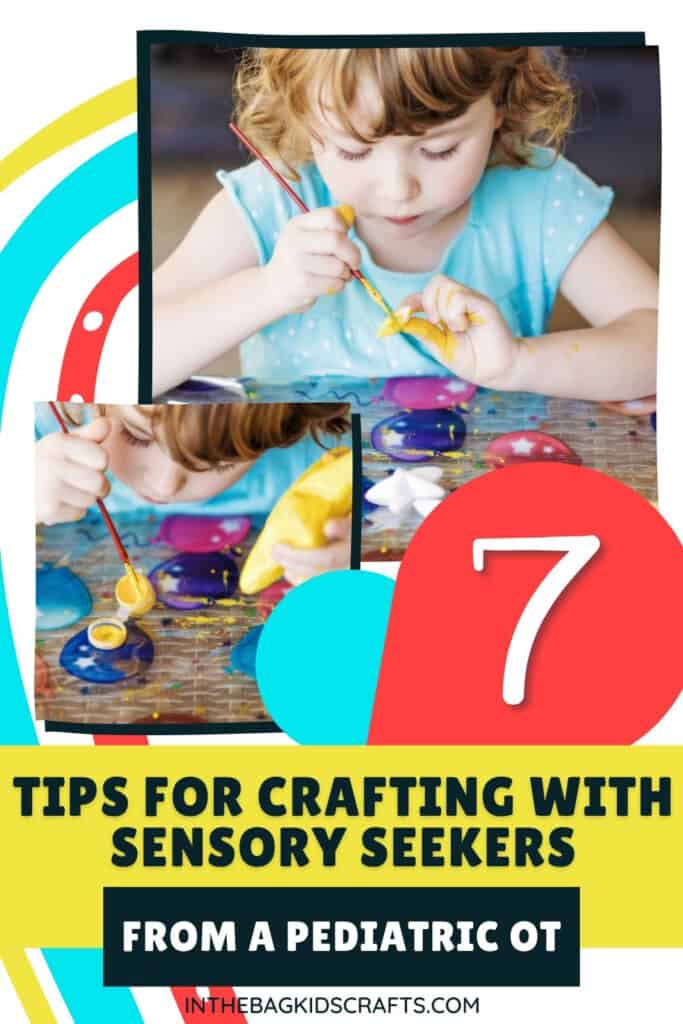7 Tips for Making Crafts with Sensory Seekers
How do you make crafts with children who are sensory seekers, constantly on the move? The benefits of crafting for kids is exponential. One bonus is that it helps children learn to attend to an activity for a period of time, bringing it from start to finish. And that is definitely a needed skill for school…and life. But not all kids are ready to sit still…for any period of time really.
I like to say that children who are “sensory seekers” are like a Big Gulp with a hole in the bottom. No matter how much movement and sensory input they get throughout their day, it just isn’t enough. So, let’s help high energy kids by making some simple adjustments to the crafting process.
Some kiddos just NEED to move. That doesn’t mean that they shouldn’t engage in arts and crafts because that would mean they would be missing out on all of the other great benefits…learning to share and other social skills, fine motor coordination, scissor skills, visual motor skills, coordinating hands together, time with friends and family…and so much more. So, how do we make crafts more accessible for the kids who are constantly in motion? I am so glad that you asked…because I have so many ideas (well, at least 7).
Save these ideas for crafting with sensory seekers. Pin them to your favorite Pinterest board…

We often call our kiddos with high energy levels “sensory seekers” because they just absolutely need movement and activity to feel settled. They are not being “bad” but just looking for their neurological needs to be met. Sensory regulation and sensory processing is such a big topic, and there is so much information out there. But here are a couple of great blog posts, written by my fellow occupational therapists, to get you started: from the INSPIRED TREEHOUSE and from THE OT TOOL BOX
1-Change Up Body Position
Maybe you have heard of the 90-90-90 posture. It is what is considered the gold standard for fine motor work…Sitting up-right with hips at 90 degrees, knees bent at 90 degrees and ankles at 90 degrees with feet flat on the floor. Good posture is the foundation efficient use of the hands. But for kiddos who have weak core muscles or who have difficulty sitting still for a period of time, let’s mix it up.
Standing is an acceptable posture for complete tabletop activities. After all, this is the trend in offices even. You have probably seen those desks that allow people to work while standing (wish I would have thought of that idea…cha ching). There are even desks connected to treadmills. If adults need movement and changes in position, it goes without saying that children would also have these needs. If your child prefers to stand and move while working, let them. You may want to move the crafts to the kitchen counter if needed (for taller kiddos). To help with proper positioning of wrists and upper extremity, you can use a slant board (or large 3 ring binder in a pinch).
For little ones who need to strength wrists and shoulders a prone position (laying on tummy) is ideal. For flat projects, tape them to the wall…preferably one that you don’t mind getting a little messy or that is very washable. Place the project in front of the child and have them work while lying on their stomach.
Another great position for working on shoulder, arm and wrist strength is lying on your back. Tape the craft to the under side of a table, requiring the crafter to reach up to complete the project. Of course, this won’t work for every project because you don’t want to have paint or gluing dripping in your face. But it is great for coloring and drawing, even some light gluing with a glue stick.
2-Separate Project and Supplies
Add some extra activity to any craft project by putting the table where the work will happen and the supplies to complete the activity in different spots in the room. For each section of the craft, the child will need to go to the table in order to retrieve the items. Going back and forth to get the supplies can be done by walking, running, hopping on one leg, skipping, jumping like a rabbit, doing the mummy walk, crawling…or any other way of moving that you can think of. Here is a dice that you can roll to decide how to move for each item that is retrieved throughout the activity. Just cut it out, fold and glue together.
3-Add Activity Breaks for Your Sensory Seekers
When you see that a kiddo is starting to lose interest or getting really “antsy”, have them take a break. Get a snack, take a walk around the room, stretch, jump on a mini trampoline, do some wall push-ups, get up and dance to a favorite song. This break can include any number of fun activities, but be sure to keep it relatively brief. It is just a short respite to refuel and then get back so that you child can also learn that when we start things, we finish them. Another great life lesson. This is a great way to help improve that attention span in kids. If they know they will have a break, they are more likely to work a little longer before needing one.
4-Crafts in the Round
In order to do “crafts in the round” you will need to be working with a group of children. This adds a fun twist and makes for some really interesting final projects. Choose a craft that has several steps for completion or a more open-ended craft (like THESE PICTURE FRAMES or THIS SUN VISOR). After each step, leave the craft in place while each kiddo moves one seat to the right. Then complete the next step, changing seats again after each step is completed. Let the children know that the craft they have in their hands when they finish their last step is the one that they will take home. If you try this one…please, please, please video tape it and share it with me. I really want to see this one in action with different kinds of crafts.
5-Scavenger Hunt Anyone?
After you have picked a craft to complete, get each supply out of the bag and put them separate ziplocs. Then hide them throughout your space. Before getting started, give your kiddo a list of the supplies to find. If there is more than once child participating, maybe you can offer a prize for the first one to find all of the items.
6-Add an Obstacle Course Element
Just like idea #2, you will place the supplies in a different area of the room, separate from the working area. But this time, make an obstacle course that will be traversed each time your child goes from craft table to supply table. Don’t buy anything special for this obstacle course, just look around to see what you already have on hand. Pillows, balls, hula hoops, jump ropes, cups, or whatever you can find. Sensory seekers particularly enjoy activities the involve jumping, climbing, or swinging. Make opportunities for crawling under, jumping over, going around, jumping on one foot, balancing on a rope, etc. If you are working outside, you can just use sidewalk chalk to form a maze to go through. Have fun with it.
7-Use a Timer
Using a timer is particularly helpful when doing crafts with kiddos who have a limited attention span. Make an agreement with your child that you will craft together until the timer goes off an then take a break. Each time the timer is set, increase the time by a little bit. For example, if you know that your child’s attention span for seated activities is extremely limited, only require 30 seconds at the first sitting. Set the timer again for the break time. As the activity time increases, the break time decreases. This is a great way to work on attending skills while doing something fun and functional. They will be so proud of what they can accomplish when the craft is finished.
I would love to hear how you implement some of these ideas for your little bundles of energy. Share in the comments, pictures please!
Save this for later! Pin it to your favorite board!

